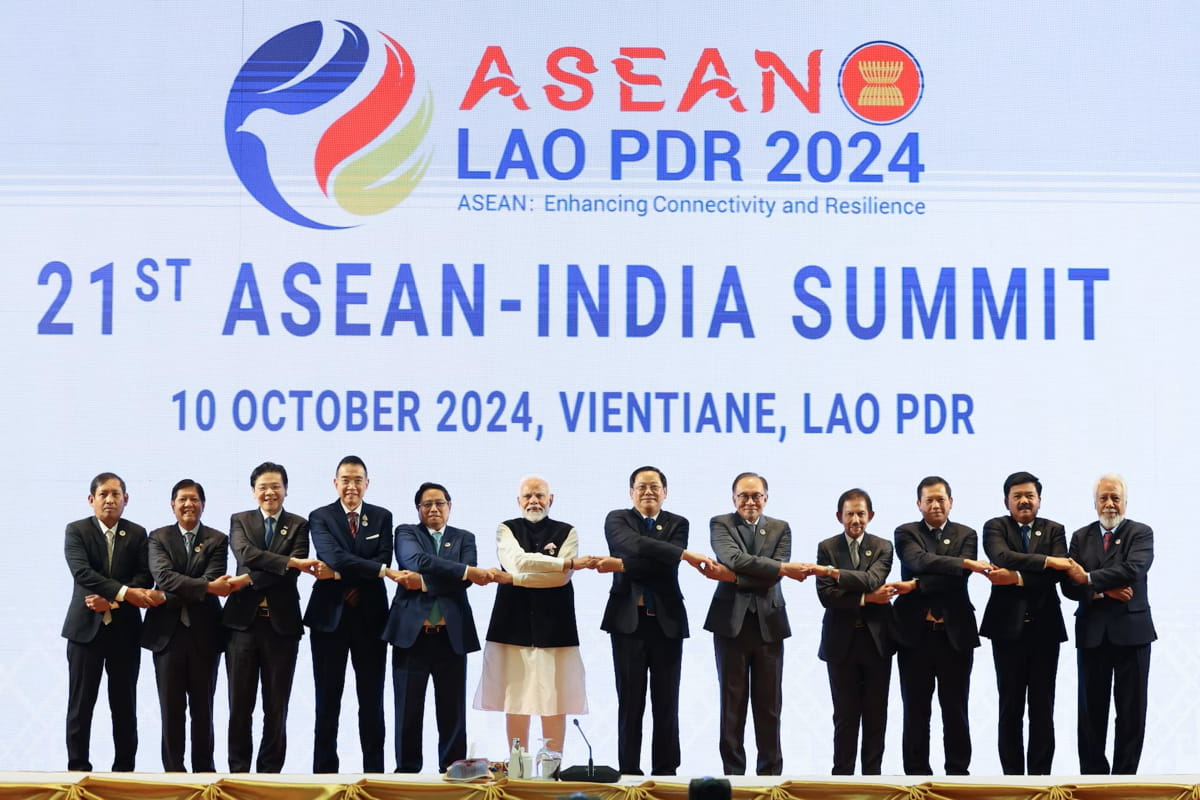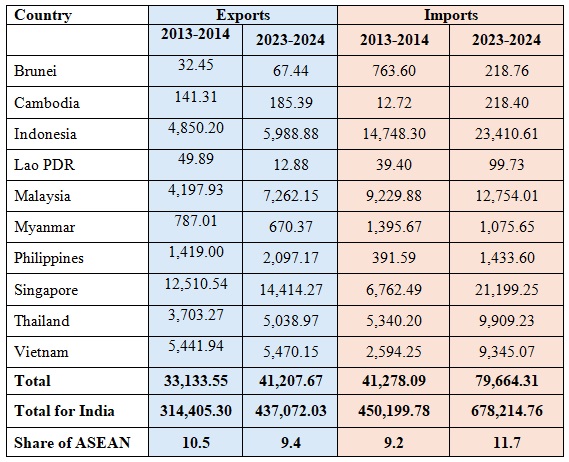
Prime Minister Narendra Modi at the 21st ASEAN-India Summit in Vientiane, Laos. | Associated Press.
India-ASEAN summits have set a strong foundation for multidimensional economic cooperation. The time is opportune to elevate trade and investment to leverage global opportunities and deepen South-South collaboration together.
Introduction
Indian Prime Minister Narendra Modi recently visite Vientiane, Lao People’s Democratic Republic for the 21st India-ASEAN summit, an annual conference that seeks to strengthen the relationship of the two proximate neighbors. This year, the two sides mark ten years of India’s Act East policy, which guides the overall relationship.
The Indian statement delivered by the Prime Minister offered ten suggestions, including declaring 2025 as the ASEAN-India Year of Tourism for which India committed USD 5 million, events for people-to-people connectivity, an annual Women Scientists’ Conclave, doubling of ASEAN students at Nalanda University, review of the ASEAN-India Trade in Goods Agreement (AITIGA), disaster resilience efforts, health resilience through institutionalizing of the ASEAN-India Health Ministers’ Meeting, institutionalizing of a cyber policy dialogue, workshops on green hydrogen and planting of trees for climate resilience.
The joint statement of the two sides stressed maritime cooperation and security, making the AITIGA more relevant, and cooperating on emerging technologies including AI in particular. Tourism, health, climate change and connectivity were the other key economic elements of the statement. Another statement was brought out on advancing digital transformation, which included opportunities in digital public infrastructure, financial technology and cross-border payment systems, cybersecurity, and AI.
ASEAN and India share geographical space and the grouping represents one of the most vibrant economic regions in the world. ASEAN members are closely connected to global value-chains and its least-developed members are rapidly integrating into the global economy as well.
At a time when the Indo-Pacific has gained in strategic relevance, India and ASEAN represent two vital nodes of the region and their enhanced cooperation on trade and economic issues is central to the ongoing restructuring of global supply chains.
Trade and investment relations
ASEAN exports to India reached around USD 67 billion in 2023, a rise from USD 48 billion in 2021. Its imports from India have gone up from USD 29 billion in 2019 to USD 35 billion in 2023, after reaching a peak of USD 42 billion in 2022.
India-ASEAN Trade, 2013-14 and 2023-24, USD million

Source: Ministry of Commerce and Industry, India
Over a period of ten years, the share of ASEAN in India’s exports has declined, while the share of ASEAN in India’s imports has risen considerably from 9.2% to 11.7%.
India’s exports to several ASEAN members have fallen during this period, including Lao and Myanmar, while exports to Vietnam stand at the same level. Imports from Singapore and Vietnam, on the other hand, have risen at a fast pace.
Looking at data from the International Trade Centre, the CAGR of India’s exports to ASEAN between 2014 and 2023 came at 2.43%; however, India’s exports to the world grew at a significantly faster CAGR of 3.11%.
At the same time, ASEAN’s imports from the world also grew faster at a CAGR of 3.45%. During this period, ASEAN’s total imports rose by about USD 500 billion, and therefore, the share of India’s exports in ASEAN imports declined. India was able to capture only USD 8.5 billion of this additional import during this period.
In terms of exports from India to ASEAN, there were 20 products valued at over USD 500 million in 2023. These products accounted for 81.5% of India’s total exports to ASEAN. The top 5 exported products include fuels, machinery, ships and boats, organic chemicals, and vehicles.
India’s imports from ASEAN expanded at a slightly faster CAGR than its total imports from the world. The largest import sources were Indonesia, Singapore, Malaysia, Thailand and Vietnam.
The top 20 imported products accounted for 89% of the total imports from ASEAN, with fuels, electronics, vegetable oils, machinery and iron and steel as the top products. Inorganic chemicals, iron and steel, copper and articles and paperboard were the fastest growing imports during 2014-2023.
Regarding investments, Singapore accounts for almost the entire FDI from ASEAN into India at USD 164 billion of a total of US 168 billion between April 2000 and June 2024, a trend that accelerated after the signing of the investment agreement between the two countries. Thailand and Malaysia are the other countries with significant investment in India.
Similarly, Singapore was the top destination for Indian companies with USD 62 billion of cumulative outward investments between April 2000 and September 2024, accounting for 20% of India’s total outward flows.
Apart from trade and investment, a range of other measures for deepening economic engagement has also been instituted. India has set up the ASEAN-India Cooperation Fund (USD 50 million, announced in 2016), ASEAN-India Green Fund (USD 5 million, established in 2007) and ASEAN-India Science and Technology Development Fund (USD 5 million established in 2007). A line of credit of USD 1 billion for connectivity projects was also offered in 2015. The ASEAN-India Fund for Digital Future which was set up earlier in 2024 would finance activities under the digital transformation statement.
Trade and transportation connectivity between the two sides has been prioritized. The Kaladan Multi-Modal Transit Transport Project initiated in 2008 as a road and inland water transport connection between India’s Mizoram and Myanmar’s Sittwe is facing delays due to various hurdles including weather, difficult terrain and security threats across the border. For the same reasons, the India-Myanmar-Thailand Trilateral Highway which was to be completed in 2015 remains unfinished. However, insufficient connectivity in the region should not deter trade and investments as the larger ASEAN countries are strong global players.
Way forward and Conclusion
Revitalising economic ties between ASEAN and India is not just an economic necessity for the two regional partners but a strategic imperative for their mutual growth, trade participation and regional prosperity. An intensive effort is required to build Indian industry’s interest in the grouping’s opportunities aside from Singapore, which dominates bilateral economic engagement. Different strategies will need to be pursued for enhancing trade and investment with the larger ASEAN economies and with the least developed economies in the group.
Since the institution of the ASEAN-India Trade in Goods Agreement, the profile of globally traded goods as well as the respective positions of India and ASEAN in manufacturing and world trade has undergone changes and these must be reflected in a new iteration of the AITIGA.
A Joint Committee has been set up for review of the AITIGA which commenced discussions in May 2023, following which five rounds of negotiations have been held starting February 2024. Eight sub-committees have deliberated on various issues and submitted views to the joint committee. The two sides aim to conclude the negotiations by 2025.
One of India’s notable concerns is the misuse of the trade agreement to reroute imports from third countries to avoid higher tariffs in India. The review of AITIGA is proposed to be comprehensive and should continue to be fast-tracked to ensure its conclusion next year. This will also support further diversification of India’s export basket.
The full benefits of the AITIGA will fructify with enhanced two-way investments in manufacturing, services, agriculture and infrastructure sectors. The current levels of investment flows from India need to be diversified across the ASEAN region, while the investment climate in India must facilitate and attract investments from the larger ASEAN countries. This can be done through greater participation of Indian embassies in connecting businesses to specific opportunities, more two-way business delegations and higher frequency of bilateral ministerial delegations accompanied by businesses.
The joint statement on advancing digital transformation presents new avenues of cooperation as well. It covers cooperation in digital public infrastructure in areas such as education, healthcare, agriculture and climate action. Financial technology cooperation with cross-border payment system linkages is also emphasized. This could be a good starting point for Indian businesses to avail of opportunities in these sectors in ASEAN.
India and ASEAN should also prioritize services trade. The two sides inked the ASEAN-India Trade in Services Agreement in 2014 which came into force in 2015. However, India has not adequately explored the opportunities in the ASEAN IT sector despite its dominant global role. In addition, India should also be able to offer professional and business services to countries in the ASEAN.
Similarly, many new opportunities are opening up in emerging sectors such as renewable energy, critical minerals mining and processing, cross-border e-commerce, green hydrogen and so on, which can be addressed by Indian businesses with encouragement from the Indian Government. India is already a key player in the vehicles segment in ASEAN and can support the shift to electric mobility in the region.
India-ASEAN summits have set a strong foundation for multidimensional economic cooperation. The time is opportune to elevate trade and investment to leverage global opportunities and deepen South-South collaboration together.
(Exclusive to NatStrat)